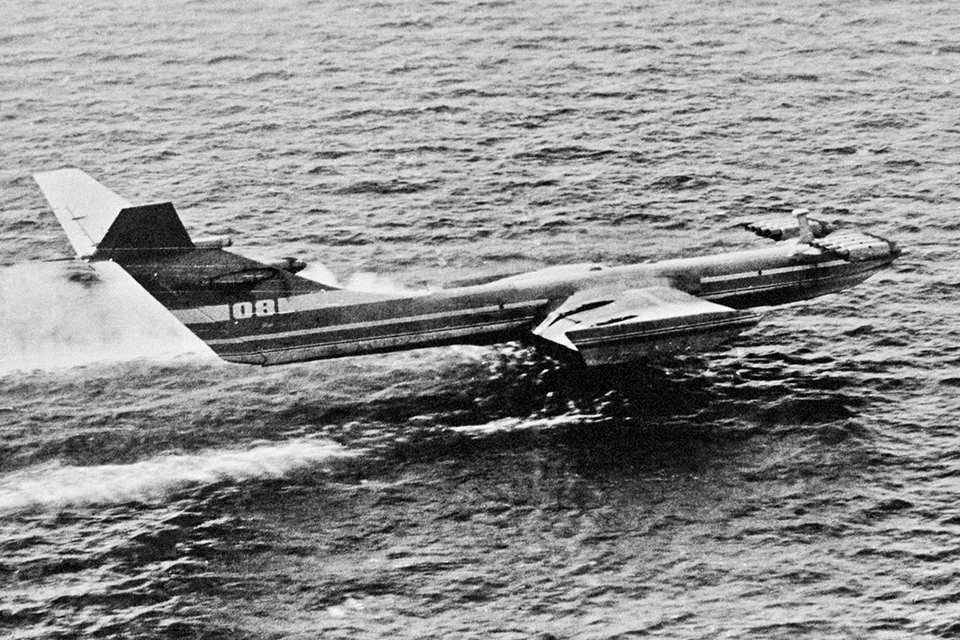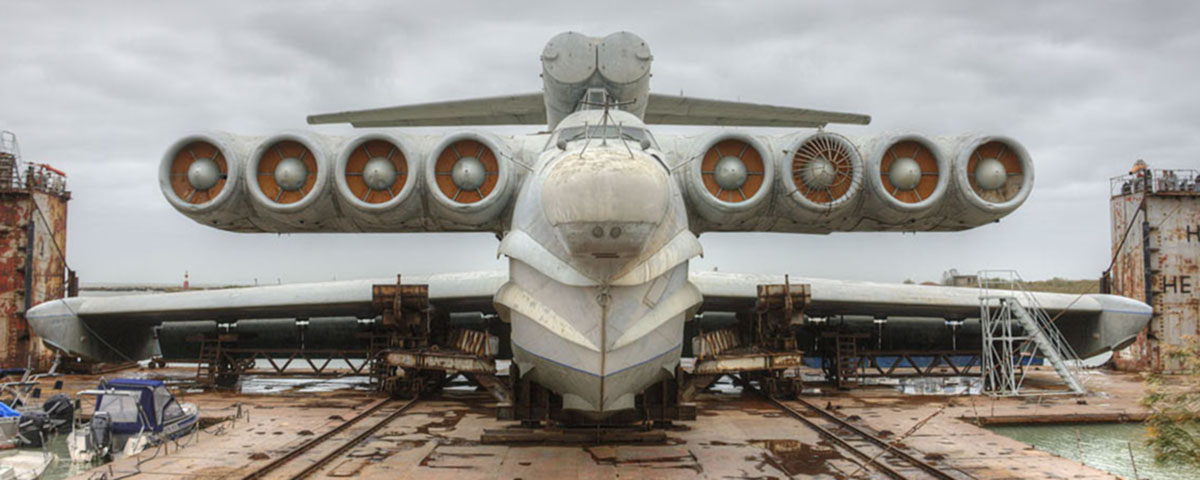Russian dreams of gigantic ground-effect planes are dead in the water.
The story of modern transportation is littered with vehicles that were supposed to be game-changers but that invariably became yet more deposits in the dustbin of history. Maglev trains, monorails, superblimps, Segways, jetpacks, hovercraft, hydrofoils, skycycles, flying cars… the list goes on. One of the strangest was a half-ship, half-airplane Soviet specialty called the ekranoplan—Russian for “ground-effect plane.” (The past tense is intentional; though there are still small ekranoplans being built by entrepreneurs and enthusiasts, and perennial proposals for ekranoplans the size of Poughkeepsie that never get any further than the pages of Popular Science, the concept is essentially, shall we say, dead in the water.)
Ekranoplans—also called WIG vehicles, for wing in ground effect—were exactly that: airplanes that flew in ground effect. Well, maybe not exactly that. Some would say that ekranoplans were not airplanes but ships that skimmed above the sea. It is perhaps telling that many photographs of cruising ekranoplans show them no farther out of the water than an unlimited hydroplane racer riding its prop. Like any well-developed bureaucracy, the Soviets wasted lots of time arguing about whether they should be developed by shipyards or aircraft companies, flown by pilots or driven by mariners, or be subject to aviation or maritime rules.
Though a Finnish engineer flew a twinengine ekranoplan in 1935 and the Soviets began to seriously develop the concept in the early 1960s, the world’s first big ekrano was actually American: Howard Hughes’ infamous eight-engine “Spruce Goose” flying boat, which flew only in ground effect, just as ekranoplans eventually would. Had that been Hughes’ intent, the H-4 Hercules might have gone on to become a successful wave-skimmer, making regular runs to Honolulu, rather than the Edsel of airplanes.
Many ekranoplan designers were actually wrong about why their quasi-airplanes flew. Until recently, generations of commercial and military ground school instructors had told their students that ground effect was created by a “cushion of air” under an airplane’s wings when it was flying close to the ground or water at a distance typically equal to half its wingspan, and the ekranoplan developers knew no better. Some still don’t. It made sense that a wing close to the ground would somehow trap a swirl of air to buoy the airplane, but it was a myth.
A harmless one, though. In the words of aircraft designer-builder and writer Peter Garrison, “Like creation myths, it offered a simple, easily memorized way to get people to stop asking unanswerable questions.” For ground effect is a complex, difficult-to-explain phenomenon best left to textbooks. And like creation myths, it is best accepted on faith. Suffice it to say that an airplane flying very close to water (or level ground, such as a runway) experiences less induced drag. The downwash angle is reduced, and this rotates the lift vector forward, thus allowing an aircraft to stay aloft using less power and less fuel (or, to put it another way, carrying more weight than it could otherwise lift outside of ground effect).
Ekranoplans certainly worked, after a fashion. The Soviet Union was blessed with several enormous bodies of water, both lakes and seas—the Caspian, Black, Baltic and Barents seas and Lake Baikal, primarily—which served as either test sites or potential operating zones for enormous cargo-, passenger-or troop-carrying ground-effect vehicles.
And enormous they were. The Soviets went straight from building small proof-of-concept vehicles to impossibly huge sea skimmers. It was as though Boeing (which itself briefly dallied with an enormous ekranoplan heavy-lifter concept called the Pelican) had looked at a Piper Cherokee and said, “Guys, I think we could scale this way up, put a bunch of turbofans on it, double-deck it and carry 1,000 passengers.”
The Soviets always had a thing for mine’s bigger-than-yours aerial gigantism. Igor Sikorsky’s 1913 Ilya Muromets was so large that crewmen strolled atop the fuselage in flight. The enormous Tupolev ANT-20 Maxim Gorky, horribly wrecked by a stunt-flying fighter over Moscow in 1935, was the biggest landplane of its time. Today’s six-engine Antonov An-225, at 1,323,000 pounds the heaviest airplane ever to fly, makes welterweights of Lockheed C-5s and double-deck Airbus A380s.
So it’s no surprise that the Soviets, and today the Russians, have been attracted to the possibilities offered by flying ships. Beriev, the company that has designed and manufactured the world’s most advanced flying boats and amphibians, started experimenting with WIG vehicles in the early 1960s. However, its only full-size, manned ekranoplan—a singleseat turbojet that was designed to use hydrofoils to lift it to a takeoff stance—never was able to achieve ground-effect flight.
Yet this hasn’t prevented Beriev from proposing WIGs so big they’d make Boeing blush. The 12-turbofan Beriev Be-2500 cargolifter, a scale model of which was unveiled at an aviation exposition in September 2000, would weigh 2,500 metric tons (2,750 U.S. tons). But wait, there’s more: The proposed Be-5000—yes, 5,000 metric tons—would have 23 engines and weigh more than eight times as much as the An-225.
Actually, very few true ekranoplans were ever built by the Soviets—perhaps 30, including small prototypes and proof-of-concept vehicles. The most impressive was the 10-jet, 550-ton KM, the so-called “Caspian Sea Monster,” which, legend has it, put the wind up the CIA when satellite surveillance showed the squat-winged, neither fish nor fowl giant under construction in the mid-1960s. The Monster today sits derelict at its Caspian Sea docking facility. The amphibious Orlyonok (Russian for eaglet), with wheels for beach assaults, was a high-speed transport with an enormous contrarotating turboprop atop its T-tail; only four ever flew, and just one survives, outside a Moscow museum. Scariest of all was the 400-ton Lun (harrier), which carried six big anti-ship missiles in launch tubes on its back; only one was built, and it too is “in storage,” essentially abandoned outdoors.

In any collection of ekranoplan photographs and illustrations, the two phrases most frequently seen in captions are “artist’s impression” and “computer-generated image.” Fevered dreams and fertile imagination have lifted far more ekranos than ground effect ever did. Many of those photos are of fancy scale models on display at airshows. Sometimes the models are of existing ekranoplans, for one ekrano problem is that if they are built on a lake or inland sea, they are pretty much trapped there forever, short of substantial disassembly for barging or trucking to a new site. Imagine building a guided-missile cruiser on the Lake of the Ozarks and then needing it for action in the Persian Gulf.
Ekranoplans can fly in ground effect over land as well as water, technically, but at 250 or 300 mph, you wouldn’t want to do it over anything but an enormous desert or a trackless prairie. And to make the concept even more confusing, the Soviets set out to develop three categories of ekranos: Type A, which could cruise only in pure ground effect; Type B, which could maintain flight out of ground effect to altitudes of perhaps 500 feet; and Type C, which supposedly could fly at thousands of feet above ground level, like a conventional airplane. (Type Cs were only proposed, never built.)
At any altitude, ekranoplans made lousy airplanes. Relatively stable longitudinally while flying very close to the water but less stable in roll, they became wallowing monstrosities, according to at least some experienced Soviet test pilots brave enough to speak their minds, when out of ground effect.
Obviously, a sophisticated, WIG-specific autopilot was needed for such situations. So ekranoplan developers, officially part of the navy’s hydrofoil-design department, asked their aviation counterparts for help. “Nonsense,” said the fly-guy bureaucrats. “Soviet aviation regulations make it illegal to use an autopilot at any altitude under 500 meters [about 1,600 feet], so there’s no point in pursuing such development.”
The promoters of enormous commercial ekranoplans eventually seemed to realize that yes, they were moderately fast, but they really didn’t have that big a payload per unit of horsepower, particularly compared to surface vessels. Proponents of military ekranoplans that would sneak across oceans under the radar to fire off missiles or land troops must have decided that radar was so 1970s, and that satellite surveillance would pick off huge, loping ekrano fleets as soon as they cast off their moorings. Tactically, ekranoplans would have been useless, able like a ship to maneuver in only one dimension, and ponderously at that. P-51s could have picked them off.
Ultimately, the Soviets’ problem was their fascination with gigantism—their overreaching to make monsters rather than developing smaller, more efficient, more utilitarian ekranos suited to the needs of their sea, lake and river commerce. Instead, they buried what might have been worthwhile efforts under what at times seemed to be a quest for world domination by ekranoplan. Today, despite mutterings about reopening the KM program, all the Russians are left with is a few corroded hulks, and dreams of what might have been.
Originally published in the November 2011 issue of Aviation History. To subscribe, click here.





